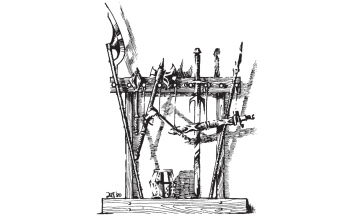I have emerged from house selling related projects to briefly think about gaming. In fact, I’m off to TotalCon this weekend, which will be a nice respite to thinking about moving. While preparing for that convention, I started creating some characters using only the Moldvay basic book. I was curious how by-the-book I could make such a character without resorting to Labyrinth Lord. The point where it broke down for me was encumberance.
Purchasing equipment in general is pretty painful using the original book. To start off, the important data about individual items is located on three different pages. First, we get to see the prices on page B12, but no other stats are listed there. The actual weight values and encumbrance chart shows up on page B20. If you’re using the optional variable damage rules, or want to know the ranges of missile weapons, well then you’ve got to flip on to page B27. Ugh.
Let’s flip directly to B20 though and look specifically at encumbrance. This is probably the most complex part of your character in Basic D&D. I also kind of think it’s a pretty important part of the game. Assuming you buy into Matt Finch‘s declaration that “managing resources is at the game’s very heart“, figuring out how much gear you can carry in and how much loot you can carry out is one of the most important pieces of data on your character sheet. Indirectly though it’s also extremely important how fast the party moves, as this will dictate the rate of consumption of other resources such as how far into the dungeon the party can go before the torches run out and how many wandering monsters will be encountered on the way.
The rules on B20 start out pretty straight forward. There’s a nice chart showing movement rates based on weight carried, which by the way is not impacted at all by any other stat. If anything, your Magic-Users are the real mules in the party, as they’re not already weighed down by heavy armor. The units are cleverly in coins, which makes it pretty easy to know how much room for treasure you have left. However, when we look at the actual weight of individual items, that’s where it falls apart.
First off, a couple things are grouped together. For example, the chart tells us a crossbow and 30 quarrels weighs 50 coins. So what’s the weight when I only have 10 quarrels left? Surely less, but how much less. The worst though is that after we see the weights of various weapons and armor, we get this entry:
Misc. equipement and provisions:
(including rope, spikes, sacks, wineskin, rations, etc.) 80 coins
Wow, how’s that for a generalization? In fact, nothing in the “Equipment” chart on page B12 is given an individual weight. It seems clear to me that the designers are just hand-waving the entire category. If you buy any additional equipment, then it weights 80, regardless of how much. One torch? 80 coins. 3 months of rations, 6 lanterns, and 2 10′ poles? 80 coins. Yikes.
My problem is that I rather like the simplified equipment list in B/X. Labyrinth Lord includes a lot of extra junk from later editions, like differentiating a light and heavy crossbow, adding goofy weapons like darts, and heck having different kinds of swords (B/X has only short, “normal”, and two-handed). I’m half tempted to use LL as a reference to figure out the weights of all the misc. equipment in B/X and create an expanded encumbrance chart. Maybe while I’m at it I could condense all the stats (cost, weight, and damage) into one chart. Hmm, sounds like I have a project on my hands.



“The units are cleverly in coins” — As you know, I think that’s one of the most major systemic mistakes in D&D.
As a historical note, as usual, the B/X encumbrance list is copy-pasted from OD&D (right down to “miscellaneous equipment” at 80 coins). On the page facing the equipment list (OD&D Vol-1, p. 15).
I don’t know, I think there is something clever about basing the weight system on the coin. Though I agree in actual use it is a bit silly to have that extra useless decimal place. LL does weights in pounds, so everything is a factor of 10 less, which means when you get to coins you’ve got to add the decimal place. I know you have an even courser grain system you use, which I tried once, but I found it difficult to use due to its not being purely decimal (all those thirds and sixths was too much for me).
Funny that the 80 coins thing was ripped right from OD&D. It does seem to me to indicate that they weren’t nearly as anal about encumbrance as I’m being. That I think is a mistake, as I outline above, your movement rate really does drive a lot of other things in the game.
It seems to me that inventory management is the one place where technology might help. I use a fillable PDF for my basic characters which automatically tallies encumbrance for you as you enter your items. Having your inventory on an iPhone or similar might really help players keep themselves honest while not allowing them to screw themselves either. Do you know how many interesting and important things my players have lost over the past year simply because nobody bothered to write it down on their character sheet?